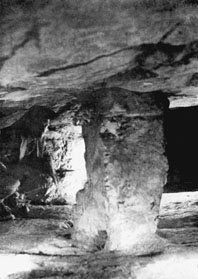

 | Page 783 |  |
the Swietokrzyskie Mountains. This was a big flint basin in a small region, and it was developed during the Paleolithic. Krzemionki Opatowskie is the unique site of this type in Europe.

Flint mine at Krzemionski Opatowskie, showing rock pillars
(Arkadiusz Marciniak)
The flint mine was exploited via a system of shafts and underground headings, and also, to a lesser degree, in a quarry (opencast) system. The mine consisted of more than one thousand shafts, a few meters in width and four to ten meters in depth. Slightly above the bottom of the shaft, there was a system of corridors alongside a siliceous rock, about sixty centimeters in height. These were sometimes enlarged in the form of bigger stalls (up to twelve by eighteen meters). The shape of the system of corridors was the result of the siliceous rock distribution, and the siliceous concretion was approximately ten to fifteen centimeters thick. For the sake of security in the mine, numerous rock pillars were left in place as mining progressed, along with other consolidations, such as limestone dumps or intentional filling by debris from mining. There was a relatively efficient system of ventilation. Loopholes were punctured near the bottom and near the top of the neighboring underground headings, making possible the circulation of air between the main shafts and the systems of corridors surrounding them. Workers in the mine used a set of mining tools made from flint and stone (chocks, axes, and flint picks), from antlers (chocks, axes), and probably from wood. The quarry or opencast mine was used to exploit the relatively scarce good-quality material found on the weathered external layer. Across the area of the whole mine, and particularly surrounding earlier shaft funnels, there are banks of waste limestone debris. Around the main field area there are remains of flint-making workshops, which produced semimanufactured tools, mainly axes and chisels.
The flint mine in Krzemionki Opatowskie was established by people of the Neolithic “Funnel Beaker Culture.” It was exploited later by people of the “Globular Amphorae Culture,” and it remained in use until the beginning of the Bronze Age. Specialized miners, living in neighboring settlements, worked the mine. In some of the bigger settlements around the mine (such as “Gawroniec” in Cmielow) there is evidence of the mass production of semimanufactured axes and chisels. A very elaborate and specialized mining and production group emerged in this area.
The flint tools (mainly axes and chisels) made from the raw material exploited in Krzemionki Opatowskie were distributed over very large areas, sometimes for more than five hundred kilometers from the mine. They can be found from the Sambia peninsula in the north, Rugen Island and Elbe river-basin in the west, and in southern Bohemia, Moravia, and Slovakia in the south. Large numbers of striped flint tools can be found in the territories of the southeastern group of Funnel Beaker Culture. Total production of the flint mine from Krzemionki Opatowskie has been estimated at around eight million semimanufactured artifacts.
The flint mine at Krzemionki Opatowskie was found by Polish geologist Jan Samsonowicz in 1922, and the first systematic excavations were undertaken by Jozef Zurowski in the years
 |  |